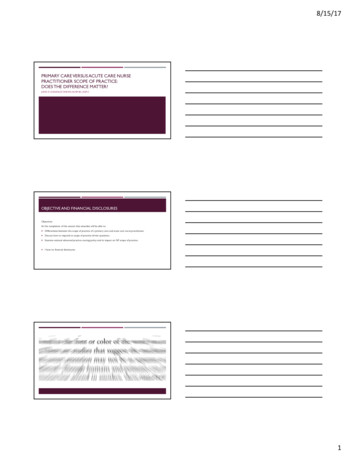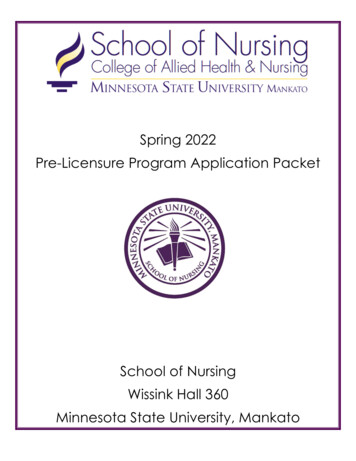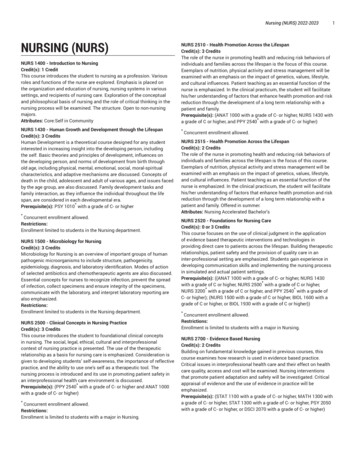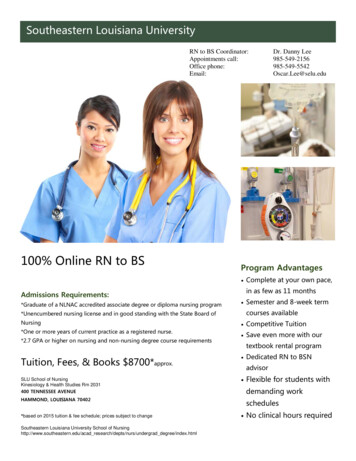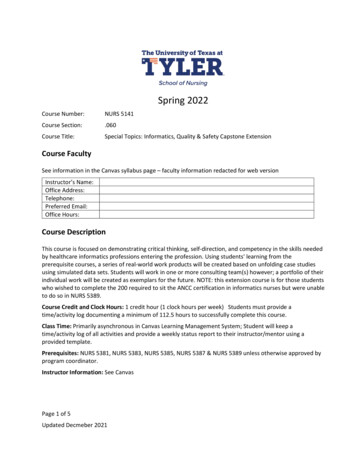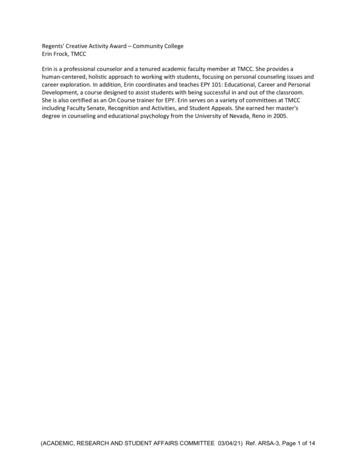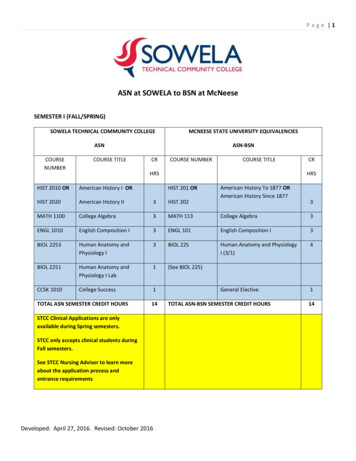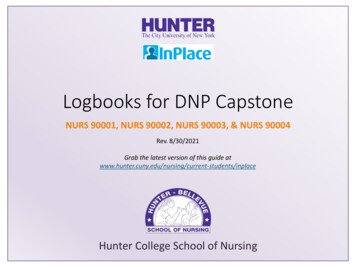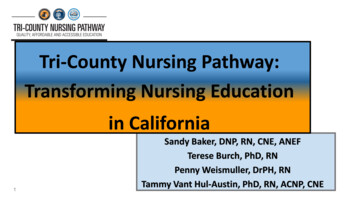
Transcription
Community Health Nursing:NURS 409 in South ParkUniversity of Washington School of Nursing students: Alix Dassler, Victoria Gasparyan, AngieGilmore, Marissa Griffith, Julie Hendricks, Ellen Kilcourse, Charlene Truong, Jakie O’Leary,Nancy Salamonsen, Galina Skrobko.Supervising Faculty: Dr. Noel ChrismanSouth Park community Participants:University of Washington School of NursingFall 2006
Community Health Nursing in South Park: fall 2006Table of ContentsAbstract .3Introduction .4Theories and Methods .8Assessment .13Planning/Implementation .17Evaluation 18Case Studies .20Sea Mar Community Health Clinic .21Park Neighborhood Information Center .27Concord Elementary School 33South Park Seniors .44South Park Community Center .59Recommendations for the Future .63References .66Appendix A 69Appendix B 70Appendix C 71Appendix D 79Appendix E 87Appendix F .1202
Community Health Nursing in South Park: fall 2006AbstractTen senior nursing students from the University of Washington spent their fall quarter of 2006completing their community clinical in the unfamiliar neighborhood of South Park. Based uponpersonal preferences and strengths, the group divided into partners and chose their site oflocation. The potential goal for the quarter was to have the students work on five distinct projectsat five different community agencies. With the setback of one groups’ project at Sea MarCommunity Health Center, only four were carried out during the quarter. The agencies included:the South Park Community Center, Concord Elementary School, South Park Senior Center, andthe South Park Neighborhood Information Center. The primary purpose of the student projectswas to collaborate with the partners of the community to identify the felt needs of the peoplewho reside within the South Park population. In addition, the students were able to experiencethe flexibility that is needed and the possibility of uncertainty that is brought forth when workingwithin the community. Descriptions of the nursing students’ community health nursing processand individual South Park projects are illustrated throughout this paper.3
Community Health Nursing in South Park: fall 2006An Introduction to South ParkTo most Seattleites, the name “South Park” typically brings to mind a crude adult cartoon,when in reality, South Park is a lot closer to home.A small and frequently overlookedneighborhood in south Seattle, South Park is a community snuggled amongst the industrial areaof the city.It was in this neighborhood that our community heath clinical took place.Weapplied the theory of community health as described by Anderson and McFarlane in which thenurses’ efforts are directed to “the achievement of social justice and equity for all” (2004).Ourrole in South Park was to work with the community organizations and leaders to identify andaddress some of their needs.By working with the community leaders to achieve their goals, thecommunity would benefit as a whole.Throughout the quarter, we learned about methods and theories of community healthnursing in lecture and from our readings.We were challenged to apply the methods we learnedin class and form lasting relationships with the community leaders, together promoting theoverall health of South Park.As we worked in South Park, we learned more about thecommunity’s history, culture, and overall identity.By combining our new understanding of theneighborhood with our knowledge from class, we were able to develop tangible efforts thatwould contribute to the community’s overall well being.South Park is located in urban Seattle, on the West Bank of the Duwamish River [SeeAppendix A for map].When you arrive at South Park from HWY 99, you are on a quaint streetin a seemingly peaceful neighborhood.You immediately come across a community center witha well manicured lawn, a soccer field, and a brand new library.with trees.The streets are wide and linedHouses range from those freshly painted with colorful window boxes to thosewhose shutters are hanging by one hinge, whose porches are full of old appliances, and whose4
Community Health Nursing in South Park: fall 2006dogs bark at you loudly from behind the chain-link fence.If you continue to travel this streetfor about 10 blocks, you will abruptly end at 14th street in the middle of town.The houses andtrees are gone and semi-trucks are barreling down the main avenue at speeds that literally rockthe local restaurants.There are a few small grocery stores, each of which offers a very limitedselection of fresh fruits and vegetables.There is no bank, no post office, and no police station.You can find, however, a couple Spanish speaking payday-loan stores and planes constantlyflying overhead.Although South Park’s geographical location and industrial surroundings makes oneinitially believe that its sense of community has been lost in the smog seen drifting above, quitethe opposite is true. One aspect of South Park that gave us a sense of community was therecently reclaimed Marra Farm.Originally owned and tended by the Marra family in the early1900’s, the 4 acre plot is one of the last two remaining pieces of agricultural land in Seattle.Restoration efforts of the land were first launched in 1997 by a handful of South Parkneighborhood residents.The next year, a group of various non-profit organizations,government programs and individuals joined together to tend to the valuable agricultural space.Since then, the success of Marra Farm has grown exponentially.In 2003, over 10,000 poundsof organic produce was grown on the farm, much of which was donated to local food banks,Concord Elementary School students, Mien community members, WIC clients, and many localresidents (2006, Fremont Public).A variety of people tend to the land, all with a similar goal toprovide “opportunities for people to garden together, learn from each other, develop a sense ofneighborhood, and create a more livable urban environment” (2006, P-Patch Trust).South Park is one of Seattle’s smallest neighborhoods whose population is only 3,717,according to the 2000 U.S. Census.With the number of undocumented immigrants in the5
Community Health Nursing in South Park: fall 2006community, this is most likely an underestimate.Hispanics makes up almost a third of SouthPark’s residents, while the city wide average is 5.3% (South Park Action Agenda, 2006).Weshould mention, however, that several ethnic minorities are present in the neighborhood.English is spoken as the primary language in over half the households, while 26% speak Spanish,and 13% speak an Asian or Pacific Island language.Thirty-four percent of South Park’sresidents were born outside of the United States, 40% of which came to the country within thelast five years.South Parks is a fairly young community, with 35% of the population beingunder the age of 20 (US Census Bureau, 2003).Compared to the rest of the Seattle area, the socioeconomic status of South Park is fairlylow.Among those over the age of 25, only 61% of South Park residents have at least a highschool degree, while the city average is almost 90%.residents live below the poverty level.Twelve and a half percent of South ParkThe per capita income in South Park is 15,826, just alittle over half that of King County which is 29, 521 (US Census Bureau, 2003).As one can see from these numbers, South Park is a community of ethnically andlinguistically diverse residents.Seattle.On average, they are relatively poor compared to the rest ofDue in part to the large number of young residents and recent immigrants living inSouth Park, the community is continually changing.These are just a few of the aspects thatmake community health nursing challenging in this neighborhood.A perfect example of how Seattle has put South Park on the back burner in the past is thestory of the South Park Public Library.In 1908, the residents of South Park first put in arequest to the city of Seattle for a neighborhood library.the summer of 2006, to complete the library.neighborhood are constantly in the works.It took the city ninety-eight years, untilEfforts by community members to improve theIn fact, in a document released to Mayor Greg6
Community Health Nursing in South Park: fall 2006Nichols in October 2006, entitled South Park Action Agenda, community leaders combined theneeds and future goals they envision for the neighborhood.They identified five issues whichneeded work in South Park; public safety, youth development, business and transportation,community engagement, and environmental and physical improvements.Each was developedby a committee which included Co-chairs, Community Members, and City Staff with a TeamLeadThe students went to the neighborhood meeting where the Action Agenda was presentedto the Mayor and saw first hand the requests.They included a new South Park Bridge, safe andattractive alternatives to driving, increasing the number of full-time police officers, and hiringbi-lingual and bi-cultural staff to work the new library just to name a few.This was livingproof for us that with teamwork and drive, community leaders and members can collaborate toorganize and accomplish many great things.As community health nursing students, our focus for the quarter was to improve theoverall health of the South Park community through collaboration and empowerment.Information about the community’s overall health and needs came from our professor, a meetingwith community leaders, and our observations from the first few weeks of the quarter.Weidentified the needs to address low WASL scores at the elementary school, child after-schoolhealth education, local and culturally competent senior services, youth character building classes,and organized and accurate information services.Following individual meetings with community leaders, we identified five separateprojects that we would work on throughout the quarter.own way.Each was unique and challenging in itsThey are described in-depth in the subsequent case studies.7
Community Health Nursing in South Park: fall 2006Theories and MethodsOur main focus of community health nursing work at South Park this quarter was ondisease prevention and health promotion. Health promotion is defined as “process of enablingpeople to increase control over and to improve their own health” (Clark, 2003, p. 224). Diseaseprevention implies “inhibiting the development of disease before it occurs,” which take place onthree levels – primary, secondary, and tertiary (Anderson & McFarlane, 2004, p. 30). Primaryprevention addresses “generally healthy population and precedes disease or dysfunction”(Anderson & McFarlane, 2004, p. 30). Secondary prevention is “the early detection andtreatment of adverse health conditions;” there as, tertiary prevention aims to “minimize disabilityand restore or preserve function” (Anderson & McFarlane, 2004, p. 31; Chrisman, 2006, 09/27).In our community health work we were on all three level of disease prevention, focusing for themost part on primary and secondary levels.In order to attain these two goals, we employed several models to guide our nursingprocess: the PRECEDE-PROCEED Model, The Community Partnership Interlocking DynamicsModel, Community-Based Participatory research (CBPR), and Community Partnership Model.In some projects that we were doing at South Park we were not able to utilize any model. In onecase it led to creation of a new model called Frustration model which is a modification of CBPR.The PRECEDE-PROCEED Model provides a detailed, comprehensive framework forguiding the processes of assessment, planning, implementation, and evaluation with the overallgoal of improving the quality of life within the community.The first five phases (socialdiagnosis, epidemiological diagnosis, behavioral and environmental diagnosis, educational andorganizational diagnosis, and administrative and policy diagnosis) represent the assessmentphase of the model, and the last four phases incorporate implementation and three phases of8
Community Health Nursing in South Park: fall 2006evaluation (Anderson & McFarlane, 2004).Each phase analyzes certain health determinantsand provides a basis for the next phase; thus identifying health problems and their origins.step-by-step process creates a highly effective tool for community health planning.ThisAccordingto Green and Kreuter (1991): “It is a theoretically ‘robust’ model that addresses a majoracknowledged need in health promotion and health education: comprehensive planning” (as citedin Hecker, 2000). A comprehensive planning model is important in community health nursingbecause it allows for the formation of the appropriate nursing interventions that address the needsof the community, resulting in positive outcomes.This model was useful in planning thedifferent projects that we organized in the South Park Community.The Community Partnership model was very useful in one of our projects whose goalwas to increase capacity within the programs already established in the community-basedorganization. Community Partnership model allows implementing research based on assessmentand evaluation.Presented as a puzzle, each piece signifies an important part of creating animpact in a community (Chrisman, 2006, 10/11).The first corner piece is called “Felt Needs.”The model emphasizes the importance of a starting point within a community.When peopleconduct work in response to the most prominent needs, it guarantees more successful outcomes.The second puzzle piece is participation.This is the active part of the community partnership.The aim is to mobilize the population into some form of participatory learning. The cornerstoneof the model is the harmony between community felt needs and the way that health care workersdesign their work within the community.This harmony makes participants feel success andempowers them to continue this type of work into the future.Empowerment, or enabling, ofthe people involved happens as a result of a recognized accomplishment.It is specificallyrealized through the act of participation. Community competence names the final puzzle piece.9
Community Health Nursing in South Park: fall 2006A competent community is one possessing skill, knowledge and the capacity to be sufficient.Sustainable work increases community competence and capacity.The Community Partnership Interlocking Dynamics Model was another method we usedto apply the community health nursing process in South Park.“The model is based on the fourlong-standing concepts around the edges (felt needs, participation, empowerment, andcommunity competence) and based on research: assessment and evaluation” (Chrisman,10/2/2006).The model uses a diagram (See Figure 2) to illustrate the process of achievingcompetence and sustainability in a community.By working with the community to createmobilization toward change and encourage joint participation of community members andcommunity health nurses, the community will thus become empowered to sustain its ownimprovements.In addition, the processes of assessment and evaluation are used in each step ofthe process and are based on qualitative and quantitative data (Chrisman, 10/2/2006).Surveysand secondary data analyses can be used to assess the community and to evaluate the effects ofthe interventions used for improvement.The use of research provides a directed andevidence-based rationale for planning, implementation, and improvement in the community.This model was used to guide our interventions for elementary school-aged children at the SouthPark Community Center.CBPR is an approach that “involves a collaborative partnership in a cyclical, iterativeprocess in which communities of identity play a lead role in: identifying community strengthsand resources; selecting priority issues to address; collecting, interpreting, and translatingresearch finding in ways that will benefit the community; and emphasizing the reciprocal transferof knowledge, skills, capacity and power” (Israel, 2000, p. 9). This approach is very different10
Community Health Nursing in South Park: fall 2006from other models because it “equitably involves community members, organizationalrepresentatives, and researchers in all aspects of the research process” (Israel, 2000, p.4).Community members are essential participants in the process identifying those unmetneeds. Because they are the experts of their own kind who gained their privileged knowledgethrough membership in the community which has its unique “sense of identification andemotional connection to other member, common symbol systems, shared values and norms,mutual influence, common interests, and commitment to meeting shared needs” (Israel, 2000, p.5). They also have first-hand knowledge about experience of living in the certain geographiclocation and being influenced by the biomedical, physical, socio-cultural, historical andpolitico-economical factors of their environment (Anderson & McFarlane, 2004; Israel et al,2000). Outside experts on the other side, “can raise questions and seed new understanding aboutthe ways people live that a community’s insiders would be unlikely to recognize without outsiderassistance” (Eng at el, 2005, p. 78).However, if community members did not identify certain issues as problems in theircommunity and do not want to work on them, no matter how hard outsiders will try change willnot be implemented because community members were not ready to address those issues yet.McKnight and Kretzmann (1997) phrased it this way: “the hard truth is that development muststart within the community” (p. 159). Therefore, active engagement of community in theresearch leads to mutual contribution and commitment to address identified problems and needs(Eng at el, 2005).Israel et al (2000) identified nine key principles that characterized CBPR model:1. Recognizes community as a unit of identity;2. Builds on strengths and resources within the community;11
Community Health Nursing in South Park: fall 20063. Facilitates collaborative, equitable involvement of all partners inall phases of theresearch4. Integrate knowledge and action for mutual benefit of all partners;5. Promotes a co-learning and empowering process that attends to social inequalities;6. Involves a cyclical and iterative process;7. Addresses health from both positive and ecological perspectives (where positiveperspective implies “physical, mental, and social well-being” and ecological viewconsiders “biomedical, social, economic, cultural, historical, and political factors asdeterminants of health and disease”);8. Disseminates findings and knowledge gained to all partners;9. Involves a long-term commitment by all partners (pp. 5-9).CBPR model values more a process of “relation building and community organizing” rather thanfinal product (Eng at el, 2005, p. 84). For that reason, CBPR approach requires long-timecommitment – at least 6 or 9 months. Even though as a class we do not spent that amount of timeon community health work due to the time constraint determined by quarter assignment, but wehave benefit of building on other nursing student’s work from previous years in view of the factthat University of Washington School of Nursing has partnership with South Park community formany years.The newly created Frustration model was developed by one group of nursing students whobegan using the CBPR model at the beginning of the quarter.However, as time passed theyexperienced many “road blocks” and frustrations that prevented their program from beingimplemented.From this they developed a new model of community health called theFrustration Model.The Frustration Model is based on the CBPR model, but the places where12
Community Health Nursing in South Park: fall 2006most would find continuation on to the next step the model explains reasons that might nothappen.At the “Community assessment” step in the CPBR Model, one can actually findthemselves “Unwelcome by the community.” This can be due to language and cultural barriersas well as finding a general disinterest of the community members in having the aid of thecommunity health nurses. At the step where the health workers are to “Involve the communityand set priorities,” there can actually be a “Differing in priorities.” The community’s prioritiescan be different than the outsider’s, they can have a lack of time for the health worker’s desiredprogram, or there can be a cultural difference in the perception of time which can prevent theprogram from being implemented.resources” road block.At the “Implement program” step, one can find a “Lack ofThe “Sustainability” step can become frustrating when the communityhealth workers experience “Loss.” They can lose funding, personnel, the community’s interest,or a variety of other resources.Finally, at the step for “Evaluation and Feedback,” one can findthat their “Evaluation toll is underappreciated” by the community members and that they maynot take the tool seriously, thus skewing the results.Although all these steps are “road blocks”and can be very frustrating, they are a reality that happens all the time.Community healthnurses should keep them in mind and be prepared to adapt and find ways of working through theproblems if they in fact do arise.Models we used not only have given us a theoreticalbackground for our work; they also provided us with “a framework for making decisions” atevery step of the nursing process (Anderson & McFarlane, 2004, p. 156).AssessmentAssessment of a community is an ongoing process where discovering the needs andresources of a community continues throughout the practitioners’ involvement in the community.In the article, A Nursing Model of Community Organization for Change there are four parts to13
Community Health Nursing in South Park: fall 2006assessing a community.They are: 1) gathering historical and current information about thecommunity 2) defining the community 3) increasing community involvement and 4) forming acommunity advisory group to assess the community’s needs and assets (Anderson,Guthrie, &Schirle, 2002).This assessment process can be applied to a neighborhood or a geographiclocation as well as a group or organization.In the context of the fall 2006 South Park group acommunity implies, “a group of people with a common background or with shared interests insociety” (Encarta Dictionary).For example, as nursing students the group assessed theSouth Park neighborhood as a whole and then we broke off into teams of two and assessed agroup or organization.This is considered a community within a community (Anderson &McFarlane, 2004).The first part of assessing a community is, “gathering historical and current informationabout the community” (Anderson,Guthrie, & Schirle, 2002).This follows the communityassessment wheel which is the assessment part of community-as-partner model (Anderson &McFarlane, 2004).The community assessment wheel suggests that the three main sourceswhere a Community Health Nurse (CHN) should gather information are from the communitycore, the subsystems and through perceptions.The community core which is at the center ofthe assessment wheel includes understanding the history, demographics, ethnicity and values andbeliefs of a community. The spokes of the assessment wheel are where a CHN gathers datafrom the subsystems.This requires evaluating the physical environment, health and socialservices, economy, transportation and safety, politics and government, communication,education and recreation.Finally, getting to know the perceptions of the people in thecommunity as well as the nurse’s perceptions helps ascertain the strengths and weaknesses of acommunity (Anderson & McFarlane, 2004).14
Community Health Nursing in South Park: fall 2006The fall 2006 South Park group collected this information through windshield surveys,informal interviews and correspondence with community members and organizers in addition toreviewing census data.These details were carefully recorded, reviewed and discussed inweekly journals and with their cohorts and instructor.Collection of this information allows theCHN to, “define” the community which is the second part to assessing a community(Anderson,Guthrie, & Schirle, 2002).Mapping Community Capacity describes this part of theassessment process as making an inventory (McKnight et al, 1997).Defining the community issimply mapping out the resources and contact information which enables the CHN to,“determine where the community members are and how to reach them” (Anderson,Guthrie, &Schirle, 2002).Each group developed their own contact lists throughout the quarter.Thisinformation was invaluable when it came time to plan, implement and evaluate a project.The next step in the process of assessing a community requires the CHN’s to immersethemselves in the community by, “increasing community involvement” (Anderson,Guthrie, &Schirle, 2002).By being present at community meetings and events and participating incommunity activities the CHN is able to network and gain the trust of community members.For example, the fall 2006 South Park nursing students attended a meeting at the South ParkCommunity Center where community partners presented their proposed, “Action Agenda” forSouth Park.Although this meeting did not directly relate to each group’s individual projectsthe nursing students were able to learn about what the community members had decided werepriorities for their neighborhood as well as make contacts with community members andorganizers.In the article, A Model for Building Collective Capacity in Community BasedPrograms the authors describe four stages of building collective capacity.In the first stage,“identifying common ground” the CHN establishes contacts for a project idea.15Included in this
Community Health Nursing in South Park: fall 2006stage is where the nurse, “gathers valuable information about how the health issue is being dealtwith in the community.” (Moyer et al. 1999)Even though certain events and activities mayseem irrelevant to a CHN’s individual project it is important to be a participant in the communityas a whole.It will likely be pertinent to the assessment process in ways that may be unforeseenat the time.The CHN should not be alone in the assessment of a community.It is important toinclude the members of a community when becoming familiar with an area or organizationwithin a community.Establishing a relationship with community members is importantbecause they are able to provide invaluable insider information to the nurse and it promotespositive relationships.It also empowers community members to lead projects so that theprograms that were developed are sustained.The last step in the assessment process is,“forming a community advisory group to assess the community’s needs and assets.”(Anderson,Guthrie, & Schirle, 2002) The fall 2006 South Park group applied this step at thebeginning of the quarter when they held a meeting with leaders in various communityorganizations.At this meeting the leaders of the community discussed the needs and assets oftheir organizations and shared ideas on how the nursing students could help.According to theAnderson,Guthrie, & Schirle, article this is the, “first step in establishing community ownershipof the program.” (2002)Even though this is the last step in the assessment model it is certainlynot meant to be performed in chronological order. Assessment of a community is an organicprocess that continues throughout the planning, implementation and evaluation phases ofcommunity involvement.16
Community Health Nursing in South Park: fall 2006Planning and ImplementationPlanning goals and objectives in community health work results from an extensiveassessment process and ends in the design of nursing interventions.“Planning is the process ofsetting goals and objectives and then designing the interventions necessary to meet the objectivesand reach the goals” (Anderson et. al, 2002).These goals and objectives are based on thenursing diagnoses of the community and must be formed in partnership with the community.Goals and objectives must also be based on the felt needs of the community.“Goals areformed when the ideas and proposals of each agency are transformed into concrete intentions ofaction” (Anderson & McFarlane, 2004).These voiced concerns of the community should formbroad and general statements that will serve as umbrella terms by which other agencies in thecommunity will have their own, more specific goals.On the other hand, objectives must bemeasurable and describe the precise changes that must take place in order to achieve the goal.“They must detail the focus of intervention (individual behavior, group norms or larger systemsand structures) and identify exactly who, when and how much change is expected to beimplemented” (Strickland, 2005, 10/12).The formation of objectives involves setting up a timeframe for the objective to be carried out, deciding who (members of the community, communityhealth nurses, etc.) will carry it out, and evaluating the magnitude of the impact it will have.Before a particular plan can be implemented, strategies must be employed in preparationfor the implementation process.“Implementation involves preparing a timeline for completionof each program objective, obtaining the necessary funding, and actually putting into action theinterventions designed during the planning phase” (Anderson
Community Health Nursing in South Park: fall 2006 8 Theories and Methods Our main focus of community health nursing work at South Park this quarter was on disease prevention and health promotion. Health promotion is defined as "process of enabling people to increase control over and to improve their own health" (Clark, 2003, p. 224). Disease

